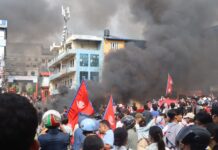A dramatic turning point in historic inter-imperialist conflict
Danny Byrne, ISA International Political Committee
(This article was first published on 14 February 2025)
Most people will remember that Donald Trump spent 2024 promising to end the war in Ukraine within “24 hours” of taking office, at times going further with the claim that he would end the fighting “before I even become president”.
After almost four weeks in power (at the time of writing), this goal is yet to be achieved, with massive bloody battles continuing to rage across Ukraine’s 1,000 kilometer-long front line.
However, on Wednesday 12 February, Trump suddenly got around to opening the Ukraine folder on his desk, and got involved in true Trumpian fashion — like a bull in a China shop. The result has left European capitals — not least Kyiv — in disarray, and marks a turning point in the evolution of this historic inter-imperialist conflict.
What is actually happening and why? And what does it mean for the juggernaut of imperialist conflict, war and militarism which, far beyond Ukraine, has dominated this new era?
What is Trump’s Ukraine policy?
Trump began the week’s chaos by announcing a “highly productive” call he had shared with Vladimir Putin, with whom he had agreed to open peace negotiations. The pair will apparently meet in Saudi Arabia in the near future, and even swapped invitations to visit each other in Washington and Moscow. This was followed by comments to reporters, some of which made for tough reading in Kyiv, musing that Ukraine “may be Russian some day” and raising question marks over the Zelensky regime’s involvement in negotiations.
This announcement came as NATO held a summit on Ukraine, attended by Trump’s recently-appointed Defense Secretary Pete Hegseth. Here, Hegseth’s prepared remarks on behalf of the US administration, which may (or may not) offer more clarity than Trump’s rambling comments, laid out Washington’s new policy. It bears quoting at some length:
“We want, like you, a sovereign and prosperous Ukraine. But we must start by recognizing that returning to Ukraine’s pre-2014 borders is an unrealistic objective.
Chasing this illusionary goal will only prolong the war and cause more suffering.
A durable peace for Ukraine must include robust security guarantees to ensure that the war will not begin again.
This must not be Minsk 3.0.
That said, the United States does not believe that NATO membership for Ukraine is a realistic outcome of a negotiated settlement.
Instead any security guarantee must be backed by capable European and non-European troops.
If these troops are deployed as peacekeepers to Ukraine at any point, they should be deployed as part of a non-NATO mission. And they should not be covered under Article 5. There also must be robust international oversight of the line of contact.
To be clear, as part of any security guarantee, there will not be U.S. troops deployed to Ukraine.”
Recognizing “hard realities”
All of this provoked much hand-wringing in European capitals, and in the pages of the Western establishment press. German Defence Minister, Boris Pistorius, criticized Trump for making concessions “before negotiations had even started”. Macron declared that only Zelensky could negotiate over Ukrainian territory and warned against “a peace that is a capitulation”.
Zelensky himself — with whom Trump had a call which “went very well” after speaking to Putin — was considerably more sanguine. While bemoaning the fact Trump spoke to Putin before him was “not pleasant” and repeating his opposition to bilateral US/Russia negotiations without Ukraine, his official response to the Trump/Putin phone call read: “No one wants peace more than Ukraine…Together with the U.S., we are charting our next steps to stop Russian aggression and ensure a lasting, reliable peace. As President Trump said, let’s get it done.”
The truth is that the essence of Trump and Hegseth’s controversial statements on the outcome of the war — that Ukraine would not recover all its 2014 territory and would not be admitted to NATO — is neither new nor particularly controversial in NATO circles. Even Zelensky has recently begun to publicly recognize the former, if not the latter. NATO — with the Biden administration to the fore — has held the door to NATO firmly closed to Ukraine throughout the war in any case. Its new Secretary General Rutte’s response to Trump’s comments described them as reflecting a “convergence that, as I said, we want peace”.
These concessions to Russia are borne of, in Hegseth’s words, “a recognition of the hard power realities on the ground”. The ultimate hard reality is that almost three years since the invasion, Russian troops have achieved the upper hand in an ongoing war of attrition. In the outcome of war, it is not the negotiating table but the battlefield which is decisive.
A crucial turning point was the disastrous Ukrainian counter-offensive of 2023. Then, amid bullish predictions of pushing Russian forces out, tens of thousands of lives, and tens of billions of US dollars and kit, were wasted in exchange for almost no territory.
Ever since, Russian troops have been slowly advancing. At the cost of heavy casualties, they took 6 times more territory in 2024 as in 2023. Russia’s massive manpower advantage and the superiority of its war-centred economy have proven decisive in attritional warfare. In response, NATO and Kyiv turned to increasingly desperate and escalatory “asymmetrical” moves in order to break the logjam, in particular the beginning of widespread drone and missile attacks within Russia, and the ongoing counter-invasion of the Kursk region. “Red lines” regarding Western military assistance were crossed one after another, but to no avail in terms of turning the tide.
As ISA has previously commented, the only way to reverse the war’s trajectory would be the direct entry of NATO armies into the war against Russia, a move which would bring the world to the brink of a terrible bloody conflagration and for which there is no appetite in the corridors of US imperialism.
The increased pace in the push for peace talks is also linked to fear that Russia’s slow advance will turn into bigger and faster breakthroughs, as decisive cities such as Pokrovsk and Chasiv Yar threaten to fall and open the way for a quicker advance across less fortified territory. In January, the influential head of Ukrainian intelligence, Budanov, commented that without serious peace talks before summer 2025, Ukraine’s existence would be threatened.
Will peace be achieved?
For these reasons, achieving an actual peace deal may prove far more complicated than Trump imagines. Indeed, some of Trump’s comments — suggesting, for example, that Ukraine might win some territory back from Russia in negotiations — betray a certain naivety regarding what kind of deal can be done. Ultimately, the key question will be whether the anatomy of a deal is both reflective of the balance of forces, and agreeable to both sides of this imperialist proxy-war.
Aware that any eventual deal will likely allow him to keep what he has conquered, Putin may have an interest in continuing the war, improving the facts on the ground from the Russian imperialist point of view. It is also possible that current events, which underline the impossibility of Ukrainian victory, have a significant effect on battlefield morale (which played a crucial role in earlier stages of the war), to Kyiv’s disadvantage.
Therefore, Putin may well play “hardball” in initial negotiations, and make demands on NATO which are unacceptable to US imperialism, even with its erratic Trumpian representatives at the table. Putin has previously ruled out agreeing to key aspects of the peace plan floated by Trump, such as the presence of large numbers of NATO “peacekeepers” in Ukraine, and still officially demands that Kyiv dismantle much of its army and surrender vast swathes of territory in the four annexed Oblasts, much of which Russian troops have not even occupied yet.
Nor is it the case that US or NATO support for Ukraine is being withdrawn. While the Trump administration indeed does desire an end to the war in order to redirect its energies elsewhere, it is fully conscious of what is at stake for the balance of imperialist power. After all, Trump unblocked Republican congress opposition to arms shipments in 2023, and military aid has continued under his administration. Even amid his most recent controversial comments, he made clear that his administration is “backing Ukraine… for as long as it takes… If we didn’t do that, then Putin would say he won”.
True to its blood-sucking imperialist nature, Trump’s administration has also had its head turned by new opportunities to loot Ukraine’s Trump’s demands, in true neocolonial fashion, that Ukraine provide $500 billion worth of rare earth minerals. The Zelensky regime nods furiously, and has been intensively discussing a “strategic partnership”, which would involve ceding control over its large rare earth reserves to the US, in exchange for past and future aid and “investment”. Trump’s US imperialism, which is pushing to seize control of Greenland for similar purposes, does not wish to see such strategic resources fall into the hands of Russian imperialism, of course.
Making NATO Great Again? European imperialists under massive pressure
Arguably more significant than Trump’s statements on Ukraine has been the laying out of his position on NATO and his demands on European powers. To quote some more from the Hegseth speech referred to earlier:
“Safeguarding European security must be an imperative for European members of NATO. As part of this Europe must provide the overwhelming share of future lethal and nonlethal aid to Ukraine.
Members of this Contact Group must meet the moment.
This means: Donating more ammunition and equipment. Leveraging comparative advantages. Expanding your defense industrial base. And importantly, leveling with your citizens about the threat facing Europe.
Part of this is speaking frankly with your people about how this threat can only be met by spending more on defense.
2% is not enough; President Trump has called for 5%, and I agree.”
He continued, with even more profound statements:
“We’re also here today to directly and unambiguously express that stark strategic realities prevent the United States of America from being primarily focused on the security of Europe.
The United States faces consequential threats to our homeland. We must — and we are — focusing on security of our own borders.
We also face a peer competitor in the Communist Chinese with the capability and intent to threaten our homeland and core national interests in the Indo-Pacific. The U.S. is prioritizing deterring war with China in the Pacific, recognizing the reality of scarcity, and making the resourcing tradeoffs to ensure deterrence does not fail.
Deterrence cannot fail, for all of our sakes.
As the United States prioritizes its attention to these threats, European allies must lead from the front.
Together, we can establish a division of labor that maximizes our comparative advantages in Europe and Pacific respectively.”
Beyond Ukraine, this policy statement is extremely important. Again, it is not a fundamentally new policy which has fallen from the sky. It builds on Obama’s “pivot to the Pacific” some thirteen years ago, the (relative) withdrawal from the Middle East under successive administrations, and the general direction of US imperialist policy during this century. But under Trump 2.0, we see it asserted more bluntly and brutally, with sword in hand, and with a firm command directed at the European powers: build up your war machines, and quickly. This is the road, says Hegseth, to “make NATO great again”.
The impact of this will be massive, and will lead to a turbo-charging of the militarist wave already flowing through the continent. At a time of deep crisis for the European capitalist powers, with economies in the doldrums and key governments in crisis and/or collapsing, the fundamental basis of European military “security” — the US guarantor — is seemingly being pulled from under their legs.
Hegseth flew from the NATO summit to Poland, for the Trump administration’s first bilateral visit in Europe. He made clear this was no accident, as Poland is the continent’s “model ally”, because it spends over 5% of GDP on defence. The doubling down of the Trump administration on this demand is sure to have huge political consequences throughout Europe.
For many European countries, meeting this figure would mean dedicating over 20% of State budgets to the army. If governments obey Trump’s commands and “level with their people” about the need for such a dramatic increase, they will also be leveling with them about a new age of austerity in welfare and public services.
But the indications are that European leaders will at least try to dance to Washington’s tune. While Macron criticized Trump’s comments on Ukraine, he welcomed his “electroshock” comments on NATO, telling the Financial Times, “What Trump is saying to Europe is that it is up to you to carry the burden. And I say, it is up to us to take it on”. Indeed, amid all the hand-wringing over Ukraine, the chief response by the liberal establishment to the week’s events throughout Europe has been to blow hard on the trumpet of militarism: the European war machine must stand on its own two feet.
Whatever their intentions, European imperialism begins from a very low starting point. Zelensky himself has pointed out that, in 2025, its armies would be completely incapable of propping up Ukraine’s war effort without the Americans. Moreover, with events pushing in the direction of the need for greater defence cooperation and coordination in Europe, the winds of the political crisis in the continent are blowing in the other direction, as European Trumpism — in the form of Le Pen, the AfD, Viktor Orban etc — grows in strength.
Impact on the imperialist bloc conflict
While Trump is fully committed to, and driven by, the global imperialist conflict with China, his leadership of the US-led bloc is clearly one of much greater volatility, which can cause significant geopolitical tremors, conflicts and even divisions within it.
Apparently, Trump does not think the US needs a bloc where anyone else has a say or is even consulted — they should just listen. For now, the European governments, including Ukraine, have little alternative but to follow. But without a change in approach from Trump it signals the beginning of a new phase, where in place of a collective bloc, Washington acts alone, and traditional capitalist allies relegated to the “kid’s table”. This could backfire on the hubris-filled administration, potentially to China’s benefit. It could also cause serious disquiet among the US ruling class, which is thus far swinging behind Trump and his acolytes.
It is also possible that Trump sees his approach to Ukraine as part of a strategy for rapprochement with the Putin regime, in order to dislodge it from its alliance with China — a so-called “reverse Kissinger”. Trump even floated the idea of readmitting Russia to the G8.
However, this is another objective which will prove much more complicated than Trump’s plans might foresee. Russia’s integration into the China-led bloc, which was qualitatively strengthened by the impact of its isolation following the beginning of the war in Ukraine, will not be so easily reversed by a new “bromance” between Putin and Trump. The ten thousand North Korean troops waging war for Putin in Kursk and the thousands of Iranian drones and missiles which have contributed to the Russian war effort will surely not be thrown into the dustbin of history, in the service of a wild zig-zag towards Washington by the Putin regime.
The only real solution — working class struggle for peace and socialism
An end to the bloodshed in Ukraine will be, whenever it comes, a welcome development for the working class in Ukraine, Russia and internationally, none of whom have had a real stake in this reactionary conflict. But this will not be the opening of a new chapter of peace in the world. Quite the contrary, in the declarations of Trump and co, it is clear that part of their calculations for seeking to end this war now, is to prepare for other, potentially greater wars in the future.
In Congo, a major new war may currently be on the horizon as fighting escalates. In the Middle East, a return to the genocidal onslaught on Gaza appears to be only a matter of time. Economic warfare — which is deeply intertwined with the war industry — is escalating rapidly.
The mass movement against the genocidal war on Gaza shows how millions of workers, young and oppressed people can take the road of struggle against war and imperialism. As governments escalate the arms race at the expense of new austerity programmes, class struggle in defence of welfare, public sector pay and services will become increasingly tied up with the struggle against militarism and imperialism.
Socialists must not only oppose wars, but take a principled stand against all imperialist interests, especially those of “our own” governments and ruling classes. In this era of imperialist bloc conflict it is critical to understand and explain the rotten interests of all powers, whose ugly fight to divide the world’s markets, wealth and resources, are driving climate catastrophe, impoverishment, famine and war.
The path forward starts with international struggle by organized working class people, which lays the basis for a movement to unite against all imperialists and warmongers. New mass political parties must be built and unite internationally, across the imperialist divide. A programme of international socialist transformation, based on taking the key levers of the economy into public democratic ownership and planning them for people and the planet, not war machines, is needed to stop endless war and bloodshed. Join ISA and fight for this perspective.




